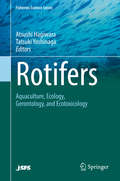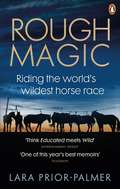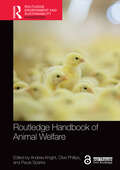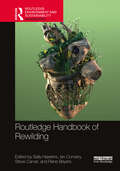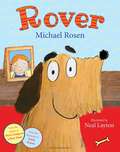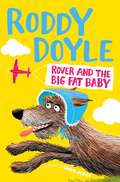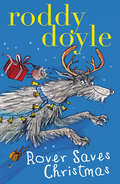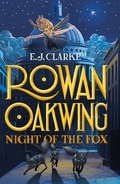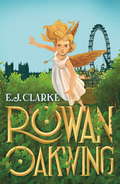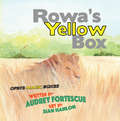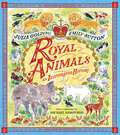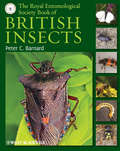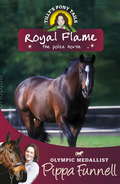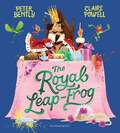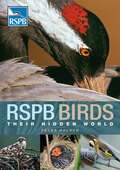- Table View
- List View
Rotifers: Aquaculture, Ecology, Gerontology, and Ecotoxicology (Fisheries Science Series)
by Atsushi Hagiwara Tatsuki YoshinagaThis book highlights the latest advances in rotifer studies in various fields including aquaculture, ecology, gerontology and ecotoxicology. The genus Brachionus are an indispensable type of zooplankton, having served as an initial live food for marine larval rearing since the 1960s. Their mass culture techniques have been intensively studied, and some essential achievements have been made – regarding high density culture, employment of valuable dietary algae, automated culture systems, and effective production of resting eggs. These have in turn supported stable and efficient aquatic seedling production for numerous important marine fish species including flounder, sea bream, and bluefin tuna. Further, this group is considered to be a suitable model for studying various aspects in ecology. A series of aquaculture and basic science studies have significantly advanced our understanding of the life history evolution. The studies in these two fields are closely linked, and provide readers with comprehensive information on how rotifers are now being employed in biological investigations.
Rottweilers For Dummies (For Dummies Ser.)
by Richard G. BeauchampKnown for its great strength, endurance, and protectiveness, the Rottweiler can be a good-natured, playful pet. It can also be a highly challenging breed. In the right hands, a Rottweiler can be the best security system in town, and at the same time, an affectionate friend to the whole family, always ready for fun and games. The well-bred, well-trained Rottweiler has the courage of a lion and is happy to obey. In the wrong hands, a Rottweiler just as easily can become an unruly beast, a menace to all that come near. Is the Rottweiler the right breed for you and your family? Rottweilers For Dummies provides the answer to this and all your questions about getting, caring for and living with this big dog. Long-time Rottweiler breeder and trainer Richard G. Beauchamp gets you up and running with what you need to know to: Choose the right Rottweiler for you Socialize your new puppy Educate yourself and your dog Maintain good health, proper exercise and diet Handle behavioral problems Participate in dog competitions In friendly, down-to-earth language, Rick provides insights into the Rottweiler temperament and loads of sensible, easy-to-follow advice on everything a Rottweiler owner should know – along with fun facts and tips on how to have a great time with your Rottie. Discover how to: Decide on whether a male or female is right for you Find and choose your new friend and bring him or her home Understand how to communicate with your Rottweiler Train your Rottweiler Finding a good trainer and attend classes Deal with emotional conflicts Feed and exercise your Rottweiler Recognize, prevent, and treat common health problems Have loyal friend for life The indispensable guide for you and your Rottweiler, Rottweilers For Dummies is the only book you’ll need to help you have the best possible experience with this admirable and loveable breed.
Rough Magic: Riding the world’s wildest horse race
by Lara Prior-Palmer'[Prior-Palmer's] gorgeous, sensual depiction of this race is a literary marvel; it feels like you are riding alongside her across the desolate steppes; her verbal acuity makes vivid the most elusive of landscapes; her triumph becomes ours' NYLONThe Mongol Derby is the world’s toughest horse race. A feat of endurance across the vast Mongolian plains once traversed by the people of Genghis Khan, competitors ride 25 horses across a distance of 1000km. Many riders don’t make it to the finish line.In 2013 Lara Prior-Palmer – nineteen, underprepared but seeking the great unknown – decided to enter the race. Driven by her own restlessness, stubbornness, and a lifelong love of horses, she raced for seven days through extreme heat and terrifying storms, catching a few hours of sleep where she could at the homes of nomadic families. Battling bouts of illness and dehydration, exhaustion and bruising falls, she found she had nothing to lose, and tore through the field with her motley crew of horses. In one of the Derby’s most unexpected results, she became the youngest-ever champion and the first woman to win the race.A tale of adventure, fortitude and poetry, Rough Magic is the extraordinary story of one young woman’s encounter with oblivion, and herself.
Routledge Handbook of Animal Welfare (Routledge Environment and Sustainability Handbooks)
by Andrew Knight, Clive Phillips, and Paula SparksThis handbook presents a much-needed and comprehensive exploration of the rapidly growing fields of animal welfare and law. In recent years there has been increasing attention paid to our complex, multifaceted relationships with other animals, and in particular, the depth and breadth of various societal uses of animals. This has led to a reconsideration of their moral and social status, which has sometimes challenged the interests of those who use animals. In such a contested domain, sound evidence and reasoning become particularly important. Through firm commitment to such principles, this book explores the biological foundations for the moral consideration of animals and for evolving conceptualisations of animal welfare. It reviews in detail the welfare concerns associated with numerous forms of animal use. The inclusion of key recent developments such as climate change, pandemics, and antimicrobial resistance, ensures this text is among the most current in its field. The ethical implications of the various uses of animals by society are considered, and chapters provide important recommendations for reforms of practice, law, or policy. The status of animal law internationally, and in major world regions, is reviewed. Finally, the book considers human behavioural change and strategies for improving stakeholder communication and education. The handbook is essential reading for students and scholars of animal welfare, animal law and animal ethics everywhere, and for policy-makers and other professionals working in the animal welfare sector.
Routledge Handbook of Animal Welfare (Routledge Environment and Sustainability Handbooks)
by Clive Phillips Andrew Knight Paula SparksThis handbook presents a much-needed and comprehensive exploration of the rapidly growing fields of animal welfare and law. In recent years there has been increasing attention paid to our complex, multifaceted relationships with other animals, and in particular, the depth and breadth of various societal uses of animals. This has led to a reconsideration of their moral and social status, which has sometimes challenged the interests of those who use animals. In such a contested domain, sound evidence and reasoning become particularly important. Through firm commitment to such principles, this book explores the biological foundations for the moral consideration of animals and for evolving conceptualisations of animal welfare. It reviews in detail the welfare concerns associated with numerous forms of animal use. The inclusion of key recent developments such as climate change, pandemics, and antimicrobial resistance, ensures this text is among the most current in its field. The ethical implications of the various uses of animals by society are considered, and chapters provide important recommendations for reforms of practice, law, or policy. The status of animal law internationally, and in major world regions, is reviewed. Finally, the book considers human behavioural change and strategies for improving stakeholder communication and education. The handbook is essential reading for students and scholars of animal welfare, animal law and animal ethics everywhere, and for policy-makers and other professionals working in the animal welfare sector.
Routledge Handbook of Insect Conservation (Routledge Environment and Sustainability Handbooks)
by Tim R. New James S. Pryke Michael J. Samways Pedro Cardoso René GaigherThis handbook presents a comprehensive overview of insect conservation and provides practical solutions to counteract insect declines, at a time where insects are facing serious threats across the world from habitat destruction to invasive species and climate change.The Routledge Handbook of Insect Conservation consist of six sections, covering all aspects of insect conservation, containing contributions from academics, researchers and practitioners from across the globe. Section I addresses the fundamentals of insect conservation and outlines the reason why insects are important and discusses the greatest drivers of insect decline. The chapters in Section II examine the approaches that can be used for insect conservation globally, such as protected areas and agroecology, while highlighting the importance of insects in the composition and function of ecosystems. The chapters in Section III focus on insect populations in the major biomes around the world, from temperate and tropical forests to savannas and grasslands, with the chapters in Section IV focusing on natural and manmade ecosystems of the world, including mountain, soil, urban, island and agricultural habitats. They discuss the unique pressures and challenges for each biome and ecosystem and offer practical solutions for conserving their insect populations. Section V focuses on the assessment and monitoring of insects for conservation, discussing how we can implement practical monitoring protocols and what options are available. A wide variety of methods and tools are examined, including citizen science, bioindication, the role of taxonomy, drones and eDNA. The book concludes by examining policy and education strategies for insect conservation in Section VI. The chapters discuss key issues around social and policy strategies and conservation legislation for ensuring the long-term protection of insects.This book is essential reading for students and scholars of biodiversity conservation and entomology as well as professionals and policymakers involved in conservation looking for real-world solutions to the threats facing insects across the globe.
Routledge Handbook of Insect Conservation (Routledge Environment and Sustainability Handbooks)
This handbook presents a comprehensive overview of insect conservation and provides practical solutions to counteract insect declines, at a time where insects are facing serious threats across the world from habitat destruction to invasive species and climate change.The Routledge Handbook of Insect Conservation consist of six sections, covering all aspects of insect conservation, containing contributions from academics, researchers and practitioners from across the globe. Section I addresses the fundamentals of insect conservation and outlines the reason why insects are important and discusses the greatest drivers of insect decline. The chapters in Section II examine the approaches that can be used for insect conservation globally, such as protected areas and agroecology, while highlighting the importance of insects in the composition and function of ecosystems. The chapters in Section III focus on insect populations in the major biomes around the world, from temperate and tropical forests to savannas and grasslands, with the chapters in Section IV focusing on natural and manmade ecosystems of the world, including mountain, soil, urban, island and agricultural habitats. They discuss the unique pressures and challenges for each biome and ecosystem and offer practical solutions for conserving their insect populations. Section V focuses on the assessment and monitoring of insects for conservation, discussing how we can implement practical monitoring protocols and what options are available. A wide variety of methods and tools are examined, including citizen science, bioindication, the role of taxonomy, drones and eDNA. The book concludes by examining policy and education strategies for insect conservation in Section VI. The chapters discuss key issues around social and policy strategies and conservation legislation for ensuring the long-term protection of insects.This book is essential reading for students and scholars of biodiversity conservation and entomology as well as professionals and policymakers involved in conservation looking for real-world solutions to the threats facing insects across the globe.
Routledge Handbook of Rewilding (Routledge Environment and Sustainability Handbooks)
by Sally Hawkins Ian Convery Steve Carver Rene BeyersThis handbook provides a comprehensive overview of the history, theory, and current practices of rewilding. Rewilding offers a transformational paradigm shift in conservation thinking, and as such is increasingly of interest to academics, policymakers, and practitioners. However, as a rapidly emerging area of conservation, the term has often been defined and used in a variety of different ways (both temporally and spatially). There is, therefore, the need for a comprehensive assessment of this field, and the Routledge Handbook of Rewilding fills this lacuna. The handbook is organised into four sections to reflect key areas of rewilding theory, practice, and debate: the evolution of rewilding, theoretical and practical underpinnings, applications and impacts, and the ethics and philosophy of rewilding. Drawing on a range of international case studies the handbook addresses many of the key issues, including land acquisition and longer-term planning, transitioning from restoration (human-led, nature enabled) to rewilding (nature-led, human enabled), and the role of political and social transformational change. Led by an editorial team who have extensive experience researching and practising rewilding, this handbook is essential reading for students, academics and practitioners interested in rewilding, ecological restoration, natural resource management and conservation.
Routledge Handbook of Rewilding (Routledge Environment and Sustainability Handbooks)
by Sally Hawkins Ian Convery Steve Carver Rene BeyersThis handbook provides a comprehensive overview of the history, theory, and current practices of rewilding. Rewilding offers a transformational paradigm shift in conservation thinking, and as such is increasingly of interest to academics, policymakers, and practitioners. However, as a rapidly emerging area of conservation, the term has often been defined and used in a variety of different ways (both temporally and spatially). There is, therefore, the need for a comprehensive assessment of this field, and the Routledge Handbook of Rewilding fills this lacuna. The handbook is organised into four sections to reflect key areas of rewilding theory, practice, and debate: the evolution of rewilding, theoretical and practical underpinnings, applications and impacts, and the ethics and philosophy of rewilding. Drawing on a range of international case studies the handbook addresses many of the key issues, including land acquisition and longer-term planning, transitioning from restoration (human-led, nature enabled) to rewilding (nature-led, human enabled), and the role of political and social transformational change. Led by an editorial team who have extensive experience researching and practising rewilding, this handbook is essential reading for students, academics and practitioners interested in rewilding, ecological restoration, natural resource management and conservation.
The Routledge Handbook of Vegan Studies (Routledge International Handbooks)
by Laura WrightThis wide-ranging volume explores the tension between the dietary practice of veganism and the manifestation, construction, and representation of a vegan identity in today’s society. Emerging in the early 21st century, vegan studies is distinct from more familiar conceptions of "animal studies," an umbrella term for a three-pronged field that gained prominence in the late 1990s and early 2000s, consisting of critical animal studies, human animal studies, and posthumanism. While veganism is a consideration of these modes of inquiry, it is a decidedly different entity, an ethical delineator that for many scholars marks a complicated boundary between theoretical pursuit and lived experience. The Routledge Handbook of Vegan Studies is the must-have reference for the important topics, problems, and key debates in the subject area and is the first of its kind. Comprising over 30 chapters by a team of international contributors, this handbook is divided into five parts: History of vegan studies Vegan studies in the disciplines Theoretical intersections Contemporary media entanglements Veganism around the world These sections contextualize veganism beyond its status as a dietary choice, situating veganism within broader social, ethical, legal, theoretical, and artistic discourses. This book will be essential reading for students and researchers of vegan studies, animal studies, and environmental ethics.
The Routledge Handbook of Vegan Studies (Routledge International Handbooks)
by Laura WrightThis wide-ranging volume explores the tension between the dietary practice of veganism and the manifestation, construction, and representation of a vegan identity in today’s society. Emerging in the early 21st century, vegan studies is distinct from more familiar conceptions of "animal studies," an umbrella term for a three-pronged field that gained prominence in the late 1990s and early 2000s, consisting of critical animal studies, human animal studies, and posthumanism. While veganism is a consideration of these modes of inquiry, it is a decidedly different entity, an ethical delineator that for many scholars marks a complicated boundary between theoretical pursuit and lived experience. The Routledge Handbook of Vegan Studies is the must-have reference for the important topics, problems, and key debates in the subject area and is the first of its kind. Comprising over 30 chapters by a team of international contributors, this handbook is divided into five parts: History of vegan studies Vegan studies in the disciplines Theoretical intersections Contemporary media entanglements Veganism around the world These sections contextualize veganism beyond its status as a dietary choice, situating veganism within broader social, ethical, legal, theoretical, and artistic discourses. This book will be essential reading for students and researchers of vegan studies, animal studies, and environmental ethics.
Rover (Bloomsbury Paperbacks Ser.)
by Michael Rosen Neal LaytonA completely topsy-turvey view of a world seen from a dog's eye point of view - a very funny story which turns to real drama when the little girl gets lost on the beach and the search is on to find her ... Layton's wildly exuberant illustrations provide the perfect accompaniment to the four legged narrator's refreshing brand of humour' The Guardian.Brilliantly read by Michael Rosen. Please note that audio is not supported by all devices, please consult your user manual for confirmation.
Rover and the Big Fat Baby (Rover Adventures Ser. #4)
by Roddy DoyleRover, canine star of The Giggler Treatment, Rover Saves Christmas and The Meanwhile Adventures is back!The BFB (Big Fat Baby) is missing!Can Rover the wonder dog and his little nephew Messi (who is actually very tidy) track her down?While Rover and co. are hot on the trail of the BFB, via Granny Mack's backpack, the post lady's basket and a plane bound for Africa, it looks like the Gigglers are about to run out of poo . . .And without an urgent delivery from Rover, how will they be able to give the Giggler Treatment to grumpy adults and help kids all over the country?In Rover and the Big Fat Baby, Rover returns for another adventure in this bestselling illustrated series by Booker Prize-winner Roddy Doyle.
Rover Saves Christmas
by Roddy DoyleIt's Christmas Eve, and disaster is looming. Jimmy and Robbie Mack have made twenty-seven sandwiches for Santa, and they've even peeled all Rudolf the reindeer's carrots! But Rudolf won't be eating carrots tonight - he's sick with the flu. Which means Santa won't be having his sandwiches either, because the sleigh is grounded and Santa is stuck! What's going to happen to all the presents? Will children across the world wake up to empty stockings on Christmas morning? Will the big day be cancelled? Or can Rover the dog save Christmas? Well... what do you think? A wonderfully comical festive story from Ireland's best-loved storyteller, Booker Prize winner Roddy Doyle.
Rowan Oakwing: Book 2 (Rowan Oakwing)
by E.J. ClarkeBeing a fairy is a lot more dangerous than you think ...Ever since Rowan was transformed into a fairy, her life has been filled with perilous adventure. And when her mum is kidnapped by evil Vulpes and his army of foxes, Rowan sets off on her most dangerous mission yet. With the help of her fairy friends - plus a tiger released from London Zoo! - she's sure she can rescue her mum and save the fairy realms. But Vulpes is cunning and sly. And he's luring Rowan right into a trap ...
Rowan Oakwing: 2 - Night Of The Fox Rowan Oakwing 2 Night Of Fox (Rowan Oakwing)
by E.J. ClarkeBeing a fairy is a lot more dangerous than you think . . .There's a strange magic to London's parks. When the sun sets and the gates are closed, tiny winged creatures come to life. The only way to meet them is to become one. And if you become one, there's no way back.Rowan cries herself to sleep in Hyde Park and wakes up ten centimetres tall, with tiny oak-leaf wings. She's about to go on an adventure in the hidden world of fairies and foxes. But Rowan's quest will be perilous, with fearsome enemies at her heels. If she wants to get home, she'll need to find the courage she never knew she had, and discover powers she'd never even imagined . . .
Rowa's Yellow Box (Opin's Magic Boxes #3)
by Audrey FortescueRowa’s Yellow Box is the third in the series of beautifully illustrated books for 3 to 6 year old children. They are family oriented stories where the children have coloured boxes to play with. But, occasionally there is something inside a box which takes the child, and other family members, on an exciting magical adventure. In this third book, Rowa is playing with her cousins Opin and Flikity when she opens a yellow box. Inside she finds bananas and a cake which take them on a magical safari adventure. They see many animals, big and small, cuddly and scary, but where did the bananas go? They return home to share the cake and snuggle up in sleeping bags to dream of their favourite animals. The books are based on the author's own family and their experiences. They make a good bedtime stories as at the end of each book the children go to bed and say “night-night”. The stories are also valuable as early readers as they incorporate many of the first words which children learn to read.
Royal Animals: A gorgeously illustrated history with a foreword by Sir Michael Morpurgo
by Julia GoldingA beautifully illustrated history of royal animals in Britain from 1066 to the present day, with a foreword by Sir Michael Morpurgo.Why do the three lions on the British crest look so much like leopards? When did the first elephant set foot on British soil? Was there really a polar bear who fished in the river Thames?Full of astounding facts and amazing true animal stories, delve in to discover royal giraffes, elephants, spaniels, parrots, ravens, pelicans and, of course, Queen Elizabeth II's corgis.Royal Animals is engagingly written, with artwork from Emily Sutton, the illustrator of Everyone Sang, William Sieghart's poetry collection. Emily is also the illustrator of Paddington creator Michael Bond's Castle Mice series.This fascinating exploration of 1000 years of royal animals is written by Julia Golding, the author of The Queen's Wardrobe, illustrated by Kate Hindley.
The Royal Entomological Society Book of British Insects
by Peter C. BarnardThe Royal Entomological Society (RES) and Wiley-Blackwell are proud to present this landmark publication, celebrating the wonderful diversity of the insects of the British Isles, and the work of the RES (founded 1833). This book is the only modern systematic account of all 558 families of British insects, covering not just the large and familiar groups that are included in popular books, but even the smallest and least known. It is beautifully illustrated throughout in full colour with photographs by experienced wildlife photographers to show the range of diversity, both morphological and behavioural, among the 24,000 species. All of the 6,000 genera of British insects are listed and indexed, along with all the family names and higher groups. There is a summary of the classification, biology and economic importance of each family together with further references for detailed identification. All species currently subject to legal protection in the United Kingdom are also listed. The Royal Entomological Society is one of the oldest and most prestigious of its kind in the world. It is the leading organisation for professional entomologists and its main aim has always been the promotion of knowledge about insects. The RES began its famous Handbooks for the Identification of British Insects in 1949, and new works in that series continue to be published. The Royal Entomological Society Book of British Insects has been produced to demonstrate the on-going commitment of the RES to educate and encourage each generation to study these fascinating creatures. This is a key reference work for serious students of entomology and amateur entomologists, as well as for professionals who need a comprehensive source of information about the insect groups of the British Isles they may be less familiar with.
The Royal Entomological Society Book of British Insects
by Peter C. BarnardThe Royal Entomological Society (RES) and Wiley-Blackwell are proud to present this landmark publication, celebrating the wonderful diversity of the insects of the British Isles, and the work of the RES (founded 1833). This book is the only modern systematic account of all 558 families of British insects, covering not just the large and familiar groups that are included in popular books, but even the smallest and least known. It is beautifully illustrated throughout in full colour with photographs by experienced wildlife photographers to show the range of diversity, both morphological and behavioural, among the 24,000 species. All of the 6,000 genera of British insects are listed and indexed, along with all the family names and higher groups. There is a summary of the classification, biology and economic importance of each family together with further references for detailed identification. All species currently subject to legal protection in the United Kingdom are also listed. The Royal Entomological Society is one of the oldest and most prestigious of its kind in the world. It is the leading organisation for professional entomologists and its main aim has always been the promotion of knowledge about insects. The RES began its famous Handbooks for the Identification of British Insects in 1949, and new works in that series continue to be published. The Royal Entomological Society Book of British Insects has been produced to demonstrate the on-going commitment of the RES to educate and encourage each generation to study these fascinating creatures. This is a key reference work for serious students of entomology and amateur entomologists, as well as for professionals who need a comprehensive source of information about the insect groups of the British Isles they may be less familiar with.
Royal Flame the Police Horse: Book 16 (Tilly's Pony Tails #16)
by Pippa FunnellMeet Tilly Redbrow, who doesn't just love horses - she lives, breathes and dreams them too! Follow Tilly's adventures as she learns to ride and care for the horses at Silver Shoe Farm, and develops her special gift, with a little help from her favourite horse, Magic Spirit.For every girl who has ever longed for a pony of her own, these delightful,warm and engaging stories are packed with Pippa Funnell's expert advice on everything you ever wanted to know about horses.
Royal Flame the Police Horse (Pippa's Pony Tales #16)
by Pippa FunnellTilly dreams of having a pony of her own. One that only she can ride to stardom. Will her wishes come true when she joins Silver Shoe Farm Stables?When there's a catastrophe at Silver Shoe Farm, Royal Flame the majestic, retired police horse remembers his training and more than lives up to his name.Collect all 18 titles in this series of irresistible, uplifting and heartwarming pony adventures. Printed in a dyslexia friendly font and packed with up to date tips from three times Olympic Medallist, Pippa Funnell, as well as a helpful glossary and black and white illustrations on every spread.
The Royal Leap-Frog
by Peter BentlyA hilarious tale of rivalry, boasting and custardy chaos from the bestselling creators of The King's Birthday Suit.When a flea, a grasshopper and a frog compete to show the King who can jump the highest, it causes CHAOS in the royal dining hall. Who can jump the highest? Can the clever leap-frog use his wits to win?And will the Emperor's dog EVER get rid of the flea?This funny and irresistible retelling of Hans Christian Andersen's classic fable, 'The Leap Frog', will make children laugh - AND show them that brains are sometimes better than brawn! With a pitch-perfect rhyming text by bestselling Peter Bently, and gloriously detailed illustrations by award-winning Claire Powell, this is an unmissable treat.
RSPB Birds: their Hidden World (RSPB)
by Peter HoldenEven if you are an enthusiastic bird watcher, the details of how birds fly, why they behave as they do, how they breed and their extraordinary travels can seem very mysterious.This lively new book aims to give readers a broad understanding of 'how birds work' from their physical make-up to courtship and breeding, social activity and their spread and travels. Readers will be able to interpret the kind of bird activity and behaviour that they see and hear in their gardens as well as in the wider countryside and on nature reserves.Designed for the general interest reader and written in a lively and accessible style, the book is presented as a series of beautifully illustrated page spreads, enhanced by fully captioned photographs and with case studies of individual species of British and European birds.
RSPB Bird’s Eye Spy
by Ms Catherine BreretonFollow a flock of swallows and see what they see in this nature book of things to spot and talk about. Fly with the birds through the cities, coasts and countryside and over mountains and markets, farms, towns, open sea, rainforests, deserts and more. Each location features ten "I-spy" animals and plants to find, with prompts and questions to give children lots to talk about. Also includes a map of the swallows' migration route and additional fascinating information about bird flight.This book is perfect for young nature enthusiasts and for parents looking for a book that will keep kids busy while encouraging them to engage with the wonder of the natural world.
